Nairi: an outstanding machine of an outstanding developer
Machines of the “Nairi” family played a significant role in the development of computer engineering in the USSR and became a worthy response to western computers. Along with the development of the car, the career of the chief designer - Hrachi Yesayevich Hovsepyan was also formed. The life path of this talented person was thorny and difficult, filled with developments and opposition to the system.
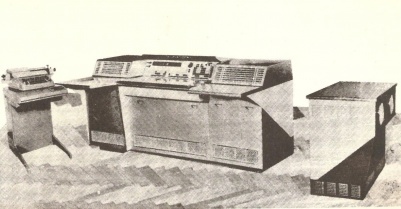
The future designer Hrachya Hovsepyan was born in 1933 in Lebanon. In 1946, together with his family, he repatriated to Armenia, where he graduated from the Physics Department of Yerevan State University. In 1956, he got a job as a laboratory assistant at a newly established regime enterprise for the creation of computers - the Yerevan Scientific Research Institute of Mathematical Machines (YerNIIIMM). The Institute was headed by a mathematician, corresponding member of the USSR Academy of Sciences and full member of the Academy of Sciences of the Armenian SSR Sergey Nikitovich Mergelyan.
')

Hrachya Yesaevich Hovsepyan
As a laboratory assistant, Ovselyan worked for the entire year, during which he grew to the head of the group. From the institute, he had a special passion for semiconductors. Therefore, I did everything possible to get into the team of Brusilovsky, who was just engaged in the development of the first Soviet computer, which was completely implemented on semiconductors. The machine was called “Hrazdan” and was part of a family of general-purpose digital electronic computers. The group under the leadership of Ovselyan worked on the control device (CU).
Over the years of work (1958–1964) on Hrazdan, Ovselyan’s authority has grown significantly. He was offered to do "small cars", which were originally presented as electronic arithmometers. But it was clear to the young developer that the machines would not be limited to the functions of the big “calculators”. Around the same time, Ovselyan seriously became interested in microprogramming and was inspired by the ideas of the British professor at the University of Cambridge, Maurice Wilks. In the early 50s, the British scientist proposed to design control automata using microinstructions that are stored in the processor's memory. This method facilitated the design of the machine and made it easy to change it. In addition, Wilkes introduced a system of mnemonic symbols for machine instructions, called assembly language.
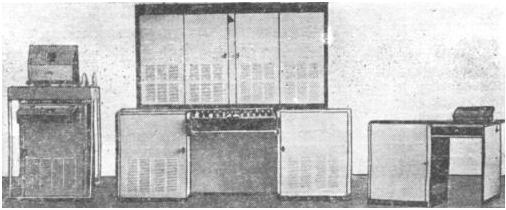
Computer "Hrazdan-2" (1961)
At the request of management, the new machine was to be built according to the type of the French model CAB-500, which was presented at the International Exhibition of Computer Technology in Moscow (1962). But after lengthy discussions and arguments on the part of the developers who wanted to create their own machine, and not copy the western one, it was decided to build a fundamentally new computer.
The development process of Nairi took several years and in 1964 the car was created. A year later, they launched a serial production of the Nairi computer.
"Nairi" belonged to the class of electronic digital computers of discrete actions of low productivity. It was performed entirely on semiconductor devices with a power consumption of about 1.6 kW. Intended for computers to solve a fairly wide range of mathematical problems arising from engineering and economic calculations and scientific research. The machine is entirely made on semiconductor devices.
"Nairi" consisted of the main machine cabinet (arithmetic unit, control unit, random access memory, long-term memory unit, external device, control panel) and power cabinet (stabilized power supply units, protection and alarm unit, control unit).

Arithmetic unit (AU) performed arithmetic and logical operations on numbers and commands, consisted of one register - adder (See). The adder contained 37 bits (the 34th to represent the fractional part of a number, the 35th to represent the integer part, the 36th to sign the number, and the 37th to be the additional one). The functions of the auxiliary registers were performed by fixed cells of the random access memory.
The control unit (CU) was intended for automatic control of the machine during the execution of a given program for solving the problem. Consisted of blocks:
- 14-bit command counter (SC), indicating the address of the cell RAM or DZU, from which you want to select the next command;
- 36-bit register of commands ( ), accepting and saving a command during its execution;
- central control unit (CUU) of a machine operating on the principle of microprogram control;
- Pulse Distribution Unit (SRI) for the formation of pulses of elementary operations that are part of a microcommand.
Random access memory (RAM) was intended for recording, storing and issuing commands and numbers, intermediate and final results of calculations. The access time to RAM was 20 microseconds. The drive was made in the form of 8 cassettes, each of which had 128 cells. Valve and line selection was made using two decoders (potential for 64 outputs and pulse for 16 outputs).
Long-term storage device (RAM) was used for storing and issuing commands, various auxiliary data and control firmware. The time for accessing the DZU was 12 microseconds. The total capacity is 16,384 numbers, of which the first 2,048 had 72 bits and were allocated for the storage of control microprograms. The rest were used to store various routines for decoding source information, automatic programming, etc. The drive consisted of 9 cells, each of which had 8 rows of oxypheres. Entering information into the cell was carried out through the firmware codes for bits and rows. The choice of address for reading data was made using potential decoders for selecting a drive cell for 8 outputs, selecting a wire for 16 outputs, selecting a row for 8 outputs, as well as a pulse decoder for selecting a wire for 16 outputs.
External device (WU) was intended to enter information into the machine and display the results of calculations. It included a printing device, a paper tape punch and a transmitter. The speed of the apparatus VU was 6 characters per second. Depending on the choice of mode, the VU could work independently of the machine offline.

Flowchart "Nairi"
The “Nairi” control panel consisted of an alarm panel (PS) and a control panel (PU). The alarm panel was used to select the desired mode of operation and light signaling. 6 modes were provided: “universal” (normal operation mode), “counting” (directly for calculations), “memory output” (data output in the form of commands or numbers), “stepping” (stopping the machine after the operation), “semi-automatic” ”(Stopping the machine after performing pseudo-operation and machine operation) and“ stopping at address ”(stopping at command address). The control panel was used for various setup work (transferring the code to different machine registers, register blanking, writing and reading RAM, etc.).
The Nairi computer was a two-address software-controlled machine with a natural command order and binary number system. Among the features worth highlighting: the ability to enter tasks in a language close to mathematics, using automatic programming for solving problems; the ability to work in a desktop counting machine. The form of representation of numbers - with a fixed comma. Subroutines performed operations on floating-point numbers.
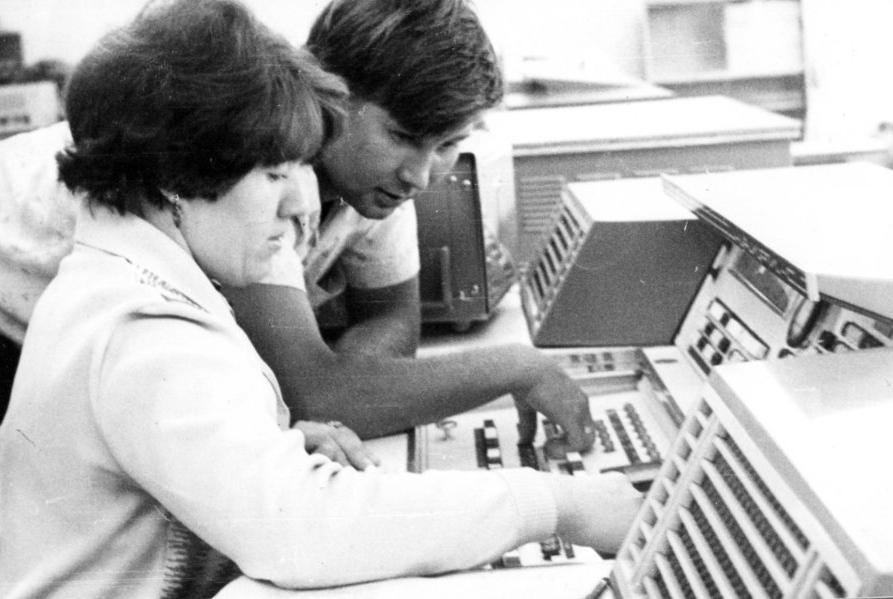
All transfers between registers, writing to random access memory, issuing codes, arithmetic operations were performed in a parallel way. Data was entered into “Nairi” using the keyboard of a printing machine or from a perforated paper tape in alphanumeric form. The results were output through printing in alphanumeric form or perforation.
An example of the average calculation speed of some tasks:
- elementary functions (such as sinx, lgx, eX, etc.) - 70 ÷ 100 msec;
- system of linear algebraic equations of the 28th order - 20 min;
- in the calculation of determinants of the 12th order - 10 min;
- inversion of the matrix of the 12th order - 12 min;
- finding the eigenvalues of the matrix of the 12th order - 14;
- finding the eigenvalues and eigenvectors of the matrix of the 12th order - 1.5 hours;
- solution of the algebraic equation of the 42nd order - 1.5 hours.
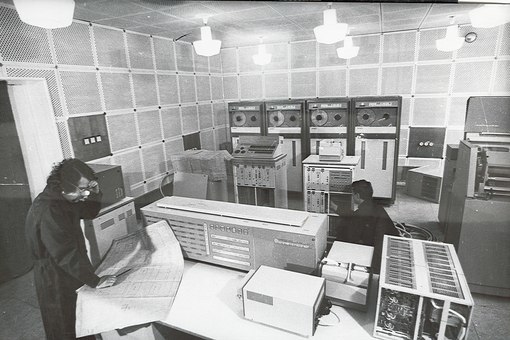
In the automatic programming mode, problems were solved without preliminary programming. The algorithm for solving the problem was given in the form of operators (instructions). The program, recorded in this form, was very similar to the usual language of mathematics. A special translator, adopting an operator program, was working. In turn, if necessary, such a work program could be derived and used as an independent one. As a result, the automatic programming mode turned “Nairi” into a machine with a more familiar and compressed language than the machine one. Operators were programmed in any sequence in accordance with the task. There were a total of 17 operators. Namely: let's say; calculate; insert; we introduce; decide; we print; program; if a; go to; interval; ask; we store; draw; we finish; stop; array; let's execute Due to the simplicity of these operators, the machine could be serviced by personnel far from programming.
As for the design of the computer, then as it was already written, it consisted of the main cabinet and the power cabinet. The main cabinet was made in the form of a desk, which allowed the operator, sitting in front of the car console, to perform all the necessary operations, but also to make corresponding marks in the magazine. A power cabinet is a separate cabinet and is connected to the main with a detachable harness. In car
there were 14 types of cells made using printed wiring. The cells were connected in blocks with printed circuit switching, the connection to which was carried out by wiring. For more convenient access to the operational storage device, the address part of the drive was brought out onto the door of the cube of RAM.
So, the output of “Nairi” in 1964 became a real sensation in the computer engineering of the USSR. The machine had a high technical level and could solve a wide range of tasks. An Association of computer users and developers was also created. At the meetings that were held every year, the participants exchanged experiences on the development and improvement of software, discussed various tasks and solutions on the use of the machine itself. The flexibility of the firmware control method made it possible to quickly make the appropriate changes to numerous modifications of the Nairi. Moreover, often even the users themselves could make the necessary changes to the computer, personalizing the machine for themselves.
From 1965 to 1967 there were various modifications of the machine. The first was "Nairi-M". It differed from the base model with a complete set of external devices - the FS-1501 photo-reading device and the PL-80 tape puncher were introduced into the periphery. Behind it appeared "Nairi-K", in which RAM increased to 4096K of words. The issue of “Nairi-S” took place in a year. As an input-output device, the Consul-254 electrified typewriter was used.
In 1966, Nairi-2 was released, which was distinguished by an increase in the amount of memory (up to 2048K of 36-bit words) and speed. More efficient I / O devices have been applied to the new model.

Documentation for "Nairi-2"
But the increased interest from the state was caused by “Nairi-3”. The car has become a serious project, for the implementation of which allocated a substantial amount of money. It was the first Soviet computer of the third generation, implemented on hybrid integrated circuits. The microprogram management principle of the first model in Nairi-3 reached the highest development and was brought to a qualitatively new level. At the same time, the possibility of compacted storage of large (up to 128 thousand micro-commands) microprogram arrays with the simultaneous sharp reduction of the access time became possible, and all the necessary conventional programming techniques were allowed. Due to this, it was possible to provide a multilingual computer structure, a time-sharing mode with simultaneous access to up to 64 terminals, each of which could perform the functions of a single Nairi-2 computer, get an advanced diagnostic system at the microprogram level, and also implement complex algorithms for specialized tasks on mixed software. - microprogram level.

"Nairi-3"
Nairi-3 met the highest technical standards of the time. Even the Americans recognized the high technology and development of the machine. It was an incredible success for developers who worked hard to create computers. Accordingly, considerable hopes were placed on the car. The plans of the governing forces were ripening the launch of a series of such computers. As a result, a group of specialists headed by Hovsepian went to Astrakhan. And in record time, they were able to debug and, with a high acceptance estimate, hand over seven operating Nairi-3 models to the factory commission. Reasonableness and high-quality study of the project allowed to produce serial machines without special skills and time-consuming. One of the remarkable features of the computer "Nairi" was their high manufacturability, allowing you to organize production in almost any company of a suitable profile.
We can consider the Nairi model as the Soviet ancestors of modern personal computers. The computer "Nairi-3" was implemented to simplify user interaction with the machine while its enrichment and expansion. Actually, “Nairi-4” was conceived as a personal computer of that time. The computer had an original architecture consisting of a complex of computational tools that allowed creating any configuration of problem-oriented machines, among which the base was a truncated processor with operational storage of tightly packed microprograms. "Nairi-4" was another milestone achievement of the Soviet computer technology.
The model "Nairi-4" was created after the departure of Ovselyan from YerNIIMM. During this period, he was at the top of his triumph, as a developer. But it so happened that his relatives were forced to apply for exit from the USSR ... This put the scientist before a difficult choice between career and family. After much deliberation, Ovselyan made a decision that literally shocked many. First he left the institute. After that, he went to Moscow, where he began to collect documents for traveling abroad. But unfortunately he did not succeed in reuniting so quickly with his family ... Ovselyan was not allowed to leave the Union, moreover, he was left in "refusers" (those who were not allowed abroad, but were not allowed to work in Soviet institutions). For almost 10 years he was in a bind, he had to work on the lowest paid and hard jobs, often on the verge of poverty and hunger.
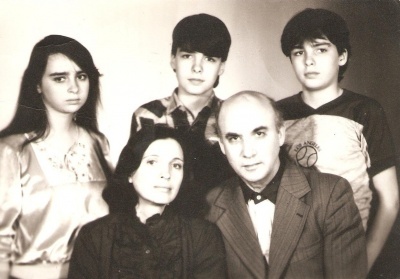
Hovsepyan with his family
Finally, at the end of 1988, thanks to the intervention of the US Congress and President Ronald Reagan personally, Hovsepian was allowed to leave his homeland. By that time, only an old mother and brother remained from his large family. The second brother and sister were no longer alive. Personal drama intensified by the fact that in the new country his talent remained unclaimed. Foreign companies reacted with disbelief to the already elderly Soviet developer, who had not worked for so many years in his specialty and knew little about modern technologies.

Hrachya Hovsepyan with a friend in the mountains of Los Angeles
And so the talented and once-outstanding scientist became a simple worker, earning his living tools. He settled in Los Angeles and got a job at a computer repair company. There he lives to this day. And let Hovsepyan's achievements in the distant past, his contribution to the Soviet computer engineering will remain permanently important, as well as the heritage in the form of “Nairi” family cars.

Beginning of the story
The future designer Hrachya Hovsepyan was born in 1933 in Lebanon. In 1946, together with his family, he repatriated to Armenia, where he graduated from the Physics Department of Yerevan State University. In 1956, he got a job as a laboratory assistant at a newly established regime enterprise for the creation of computers - the Yerevan Scientific Research Institute of Mathematical Machines (YerNIIIMM). The Institute was headed by a mathematician, corresponding member of the USSR Academy of Sciences and full member of the Academy of Sciences of the Armenian SSR Sergey Nikitovich Mergelyan.
')
Yerevan Institute of Mathematical Machines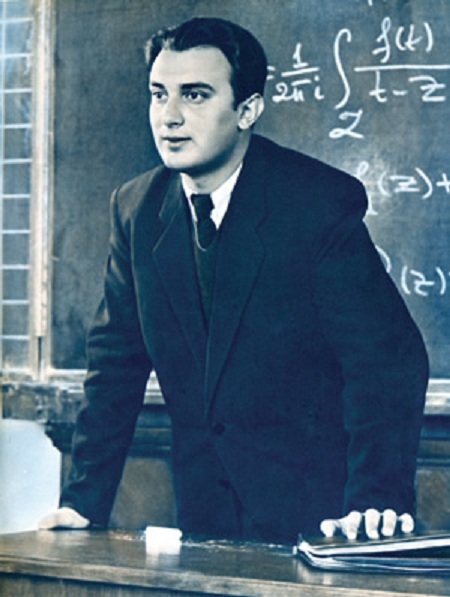
Sergey Nikitovich Mergelyan (1928 - 2008).
The Yerevan Institute of Mathematical Machines was organized by a talented mathematician Sergey Mergelyan - the youngest doctor of science in the history of the USSR (degree awarded in the defense of his doctoral dissertation at 20 years old) and corresponding member of the USSR Academy of Sciences (received the title at 24 years old). His brilliant abilities and achievements in science made such a strong impression on the country's top leadership that the Soviet government found it necessary to create an appropriate institution in Yerevan. Naturally, S. Mergelyan himself became the director of the institute. He put a lot of effort into the development and formation of this scientific institution, which in the future gave the USSR wonderful Nairi cars.
The institute was formed functional units for the design of hardware and software, including their design and technological equipment. In addition, they launched workshops for the manufacture of samples of devices and components, including power supplies. In the future, the individual workshops were united in a pilot production, and later in the Pilot Plant YerNIIMM.

Sergey Nikitovich Mergelyan (1928 - 2008).
The Yerevan Institute of Mathematical Machines was organized by a talented mathematician Sergey Mergelyan - the youngest doctor of science in the history of the USSR (degree awarded in the defense of his doctoral dissertation at 20 years old) and corresponding member of the USSR Academy of Sciences (received the title at 24 years old). His brilliant abilities and achievements in science made such a strong impression on the country's top leadership that the Soviet government found it necessary to create an appropriate institution in Yerevan. Naturally, S. Mergelyan himself became the director of the institute. He put a lot of effort into the development and formation of this scientific institution, which in the future gave the USSR wonderful Nairi cars.
The institute was formed functional units for the design of hardware and software, including their design and technological equipment. In addition, they launched workshops for the manufacture of samples of devices and components, including power supplies. In the future, the individual workshops were united in a pilot production, and later in the Pilot Plant YerNIIMM.

Hrachya Yesaevich Hovsepyan
As a laboratory assistant, Ovselyan worked for the entire year, during which he grew to the head of the group. From the institute, he had a special passion for semiconductors. Therefore, I did everything possible to get into the team of Brusilovsky, who was just engaged in the development of the first Soviet computer, which was completely implemented on semiconductors. The machine was called “Hrazdan” and was part of a family of general-purpose digital electronic computers. The group under the leadership of Ovselyan worked on the control device (CU).
Over the years of work (1958–1964) on Hrazdan, Ovselyan’s authority has grown significantly. He was offered to do "small cars", which were originally presented as electronic arithmometers. But it was clear to the young developer that the machines would not be limited to the functions of the big “calculators”. Around the same time, Ovselyan seriously became interested in microprogramming and was inspired by the ideas of the British professor at the University of Cambridge, Maurice Wilks. In the early 50s, the British scientist proposed to design control automata using microinstructions that are stored in the processor's memory. This method facilitated the design of the machine and made it easy to change it. In addition, Wilkes introduced a system of mnemonic symbols for machine instructions, called assembly language.
Computer "Hrazdan-2" (1961)
At the request of management, the new machine was to be built according to the type of the French model CAB-500, which was presented at the International Exhibition of Computer Technology in Moscow (1962). But after lengthy discussions and arguments on the part of the developers who wanted to create their own machine, and not copy the western one, it was decided to build a fundamentally new computer.
The development process of Nairi took several years and in 1964 the car was created. A year later, they launched a serial production of the Nairi computer.
Characteristics of "Nairi"
"Nairi" belonged to the class of electronic digital computers of discrete actions of low productivity. It was performed entirely on semiconductor devices with a power consumption of about 1.6 kW. Intended for computers to solve a fairly wide range of mathematical problems arising from engineering and economic calculations and scientific research. The machine is entirely made on semiconductor devices.
"Nairi" consisted of the main machine cabinet (arithmetic unit, control unit, random access memory, long-term memory unit, external device, control panel) and power cabinet (stabilized power supply units, protection and alarm unit, control unit).

Arithmetic unit (AU) performed arithmetic and logical operations on numbers and commands, consisted of one register - adder (See). The adder contained 37 bits (the 34th to represent the fractional part of a number, the 35th to represent the integer part, the 36th to sign the number, and the 37th to be the additional one). The functions of the auxiliary registers were performed by fixed cells of the random access memory.
The control unit (CU) was intended for automatic control of the machine during the execution of a given program for solving the problem. Consisted of blocks:
- 14-bit command counter (SC), indicating the address of the cell RAM or DZU, from which you want to select the next command;
- 36-bit register of commands ( ), accepting and saving a command during its execution;
- central control unit (CUU) of a machine operating on the principle of microprogram control;
- Pulse Distribution Unit (SRI) for the formation of pulses of elementary operations that are part of a microcommand.
Random access memory (RAM) was intended for recording, storing and issuing commands and numbers, intermediate and final results of calculations. The access time to RAM was 20 microseconds. The drive was made in the form of 8 cassettes, each of which had 128 cells. Valve and line selection was made using two decoders (potential for 64 outputs and pulse for 16 outputs).
Long-term storage device (RAM) was used for storing and issuing commands, various auxiliary data and control firmware. The time for accessing the DZU was 12 microseconds. The total capacity is 16,384 numbers, of which the first 2,048 had 72 bits and were allocated for the storage of control microprograms. The rest were used to store various routines for decoding source information, automatic programming, etc. The drive consisted of 9 cells, each of which had 8 rows of oxypheres. Entering information into the cell was carried out through the firmware codes for bits and rows. The choice of address for reading data was made using potential decoders for selecting a drive cell for 8 outputs, selecting a wire for 16 outputs, selecting a row for 8 outputs, as well as a pulse decoder for selecting a wire for 16 outputs.
External device (WU) was intended to enter information into the machine and display the results of calculations. It included a printing device, a paper tape punch and a transmitter. The speed of the apparatus VU was 6 characters per second. Depending on the choice of mode, the VU could work independently of the machine offline.

Flowchart "Nairi"
The “Nairi” control panel consisted of an alarm panel (PS) and a control panel (PU). The alarm panel was used to select the desired mode of operation and light signaling. 6 modes were provided: “universal” (normal operation mode), “counting” (directly for calculations), “memory output” (data output in the form of commands or numbers), “stepping” (stopping the machine after the operation), “semi-automatic” ”(Stopping the machine after performing pseudo-operation and machine operation) and“ stopping at address ”(stopping at command address). The control panel was used for various setup work (transferring the code to different machine registers, register blanking, writing and reading RAM, etc.).
The Nairi computer was a two-address software-controlled machine with a natural command order and binary number system. Among the features worth highlighting: the ability to enter tasks in a language close to mathematics, using automatic programming for solving problems; the ability to work in a desktop counting machine. The form of representation of numbers - with a fixed comma. Subroutines performed operations on floating-point numbers.

All transfers between registers, writing to random access memory, issuing codes, arithmetic operations were performed in a parallel way. Data was entered into “Nairi” using the keyboard of a printing machine or from a perforated paper tape in alphanumeric form. The results were output through printing in alphanumeric form or perforation.
An example of the average calculation speed of some tasks:
- elementary functions (such as sinx, lgx, eX, etc.) - 70 ÷ 100 msec;
- system of linear algebraic equations of the 28th order - 20 min;
- in the calculation of determinants of the 12th order - 10 min;
- inversion of the matrix of the 12th order - 12 min;
- finding the eigenvalues of the matrix of the 12th order - 14;
- finding the eigenvalues and eigenvectors of the matrix of the 12th order - 1.5 hours;
- solution of the algebraic equation of the 42nd order - 1.5 hours.

In the automatic programming mode, problems were solved without preliminary programming. The algorithm for solving the problem was given in the form of operators (instructions). The program, recorded in this form, was very similar to the usual language of mathematics. A special translator, adopting an operator program, was working. In turn, if necessary, such a work program could be derived and used as an independent one. As a result, the automatic programming mode turned “Nairi” into a machine with a more familiar and compressed language than the machine one. Operators were programmed in any sequence in accordance with the task. There were a total of 17 operators. Namely: let's say; calculate; insert; we introduce; decide; we print; program; if a; go to; interval; ask; we store; draw; we finish; stop; array; let's execute Due to the simplicity of these operators, the machine could be serviced by personnel far from programming.
As for the design of the computer, then as it was already written, it consisted of the main cabinet and the power cabinet. The main cabinet was made in the form of a desk, which allowed the operator, sitting in front of the car console, to perform all the necessary operations, but also to make corresponding marks in the magazine. A power cabinet is a separate cabinet and is connected to the main with a detachable harness. In car
there were 14 types of cells made using printed wiring. The cells were connected in blocks with printed circuit switching, the connection to which was carried out by wiring. For more convenient access to the operational storage device, the address part of the drive was brought out onto the door of the cube of RAM.
Success
So, the output of “Nairi” in 1964 became a real sensation in the computer engineering of the USSR. The machine had a high technical level and could solve a wide range of tasks. An Association of computer users and developers was also created. At the meetings that were held every year, the participants exchanged experiences on the development and improvement of software, discussed various tasks and solutions on the use of the machine itself. The flexibility of the firmware control method made it possible to quickly make the appropriate changes to numerous modifications of the Nairi. Moreover, often even the users themselves could make the necessary changes to the computer, personalizing the machine for themselves.
From 1965 to 1967 there were various modifications of the machine. The first was "Nairi-M". It differed from the base model with a complete set of external devices - the FS-1501 photo-reading device and the PL-80 tape puncher were introduced into the periphery. Behind it appeared "Nairi-K", in which RAM increased to 4096K of words. The issue of “Nairi-S” took place in a year. As an input-output device, the Consul-254 electrified typewriter was used.
"Nairi-2" and "Nairi-3"
In 1966, Nairi-2 was released, which was distinguished by an increase in the amount of memory (up to 2048K of 36-bit words) and speed. More efficient I / O devices have been applied to the new model.

Documentation for "Nairi-2"
But the increased interest from the state was caused by “Nairi-3”. The car has become a serious project, for the implementation of which allocated a substantial amount of money. It was the first Soviet computer of the third generation, implemented on hybrid integrated circuits. The microprogram management principle of the first model in Nairi-3 reached the highest development and was brought to a qualitatively new level. At the same time, the possibility of compacted storage of large (up to 128 thousand micro-commands) microprogram arrays with the simultaneous sharp reduction of the access time became possible, and all the necessary conventional programming techniques were allowed. Due to this, it was possible to provide a multilingual computer structure, a time-sharing mode with simultaneous access to up to 64 terminals, each of which could perform the functions of a single Nairi-2 computer, get an advanced diagnostic system at the microprogram level, and also implement complex algorithms for specialized tasks on mixed software. - microprogram level.

"Nairi-3"
Nairi-3 met the highest technical standards of the time. Even the Americans recognized the high technology and development of the machine. It was an incredible success for developers who worked hard to create computers. Accordingly, considerable hopes were placed on the car. The plans of the governing forces were ripening the launch of a series of such computers. As a result, a group of specialists headed by Hovsepian went to Astrakhan. And in record time, they were able to debug and, with a high acceptance estimate, hand over seven operating Nairi-3 models to the factory commission. Reasonableness and high-quality study of the project allowed to produce serial machines without special skills and time-consuming. One of the remarkable features of the computer "Nairi" was their high manufacturability, allowing you to organize production in almost any company of a suitable profile.
"Nairi-4"
We can consider the Nairi model as the Soviet ancestors of modern personal computers. The computer "Nairi-3" was implemented to simplify user interaction with the machine while its enrichment and expansion. Actually, “Nairi-4” was conceived as a personal computer of that time. The computer had an original architecture consisting of a complex of computational tools that allowed creating any configuration of problem-oriented machines, among which the base was a truncated processor with operational storage of tightly packed microprograms. "Nairi-4" was another milestone achievement of the Soviet computer technology.
The fate of the creator
The model "Nairi-4" was created after the departure of Ovselyan from YerNIIMM. During this period, he was at the top of his triumph, as a developer. But it so happened that his relatives were forced to apply for exit from the USSR ... This put the scientist before a difficult choice between career and family. After much deliberation, Ovselyan made a decision that literally shocked many. First he left the institute. After that, he went to Moscow, where he began to collect documents for traveling abroad. But unfortunately he did not succeed in reuniting so quickly with his family ... Ovselyan was not allowed to leave the Union, moreover, he was left in "refusers" (those who were not allowed abroad, but were not allowed to work in Soviet institutions). For almost 10 years he was in a bind, he had to work on the lowest paid and hard jobs, often on the verge of poverty and hunger.

Hovsepyan with his family
Finally, at the end of 1988, thanks to the intervention of the US Congress and President Ronald Reagan personally, Hovsepian was allowed to leave his homeland. By that time, only an old mother and brother remained from his large family. The second brother and sister were no longer alive. Personal drama intensified by the fact that in the new country his talent remained unclaimed. Foreign companies reacted with disbelief to the already elderly Soviet developer, who had not worked for so many years in his specialty and knew little about modern technologies.

Hrachya Hovsepyan with a friend in the mountains of Los Angeles
And so the talented and once-outstanding scientist became a simple worker, earning his living tools. He settled in Los Angeles and got a job at a computer repair company. There he lives to this day. And let Hovsepyan's achievements in the distant past, his contribution to the Soviet computer engineering will remain permanently important, as well as the heritage in the form of “Nairi” family cars.
Source: https://habr.com/ru/post/368765/
All Articles